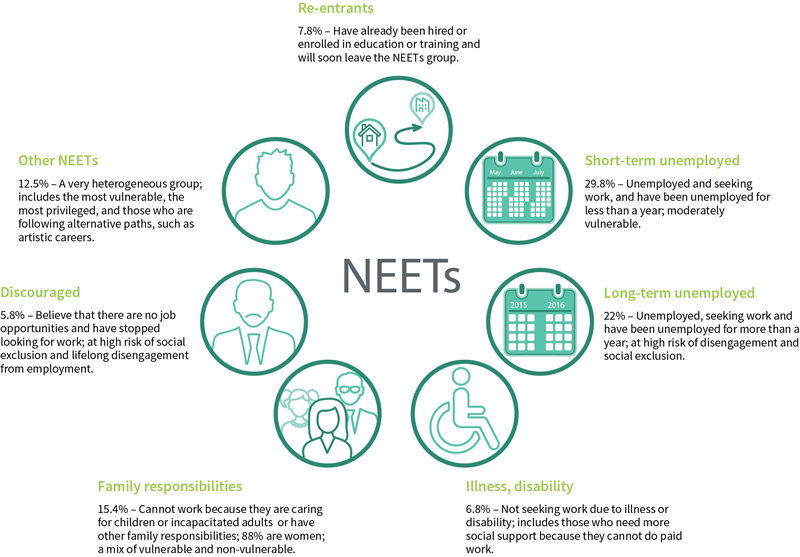EU context
El concepto se ha empleado de forma generalizada como indicador para informar políticas orientadas a la juventud sobre empleabilidad, educación, formación e inclusión social en los 28 Estados miembros desde 2010.
Se aludió específicamente a los NiNis por primera vez en los debates políticos europeos en la iniciativa emblemática de Europa 2020 «Juventud en movimiento». La categoría de edad que abarca el término era de 15 a 24 años, y posteriormente se amplió para incluir a personas de entre 15 y 29 años. Actualmente el concepto está integrado en el discurso político a nivel de la UE. En la actualidad, los NiNis representan un 14,2 % de la población de entre 15 y 29 años de edad.
En abril de 2013 se adoptó la propuesta de la Comisión Europea al Consejo de la Unión Europea sobre el establecimiento de una Garantía Juvenil. La reducción de las cifras de NiNis es un objetivo político explícito de la Garantía Juvenil. Esta iniciativa pretende garantizar que todos los jóvenes entre 15 y 24 años reciban una oferta de empleo, educación continua, aprendizaje profesional o período de prácticas de buena calidad en un plazo de cuatro meses desde que queden desempleados o abandonen la educación formal. El despliegue de la Garantía Juvenil en los Estados miembros, a través de la Iniciativa de Empleo Juvenil, ha contribuido a mejorar la situación sobre el terreno, reduciendo el número de NiNis.
Más recientemente, el 7 de diciembre de 2016, la Comisión Europea lanzó la iniciativa Invertir en la Juventud de Europa, un esfuerzo renovado para apoyar a los jóvenes. Dado el impacto positivo de la Garantía Juvenil hasta la fecha, la Comisión pretende impulsar y ampliar la financiación disponible para la Iniciativa de Empleo Juvenil hasta 2020, para promover que se llegue de forma más eficaz a los jóvenes.
La labor de Eurofound
Con la aplicación de la Garantía Juvenil, la cifra de NiNis entre 15 y 29 años ha disminuido ligeramente, pasando de unos 14 millones en el punto álgido de la crisis a 12,5 millones en 2016 (14,2 %). No obstante, las investigaciones de Eurofound siguen calculando una pérdida considerable para las economías europeas, de alrededor de 142 000 millones EUR al año (2015), en calidad y prestaciones, ingresos no percibidos e impuestos. Esto tiene una repercusión considerable sobre el desarrollo económico y social de la UE.
Aportaciones fundamentales
Hasta la fecha, Eurofound ha sido pionera en una amplia investigación sobre NiNis (véanse la publicaciones más abajo) y ha:
- realizado el primer análisis comparativo de la UE sobre NiNis;
- explicado quiénes son los NiNis;
- calculado los costes económicos de los NiNis;
- investigado las consecuencias sociales de los NiNis;
- estimado los factores de riesgo de entrar en la categoría de NiNi;
- investigado la eficacia de las políticas de reintegración de NiNis;
- supervisado la aplicación de la Garantía Juvenil.
Diversidad de los NiNis
Dentro de su investigación, Eurofound ha tratado de descifrar la heterogeneidad de la población NiNi. El estudio más reciente sobre la diversidad de los NiNis proporciona una nueva clasificación en siete subgrupos, a fin de comprender mejor la composición de este grupo de jóvenes. El objetivo es ayudar de una mejor forma a los responsables de las políticas a comprender quiénes son los NiNis y a contribuir al diseño de medidas de apoyo adecuadas para satisfacer una amplia gama de necesidades. Cada uno de estos grupos está formado por una combinación de jóvenes vulnerables y no vulnerables que no acumulan capital humano a través de canales formales, ya sea de forma voluntaria o involuntaria.
Otros temas de investigación
Además del estudio anteriormente mencionado, en los últimos años Eurofound ha estudiado (véanse las publicaciones más abajo):
- las características y valores del espíritu empresarial de la juventud;
- cómo involucrar al «vacío intermedio»: jóvenes con educación secundaria que no siguen el camino académico hacia la educación superior;
- la inclusión social de los jóvenes;
- las transiciones de los jóvenes en el mercado laboral;
- el aumento en el empleo temporal entre los jóvenes y el acceso a la protección social;
- las condiciones de trabajo de los jóvenes que acceden al mercado laboral;
- los avances políticos recientes en relación con los NiNis.
Véase la lista de publicaciones más abajo.
Destacado: análisis de la diversidad de la población NiNi
4 de julio de 2016 - A partir del informe de 2012 de Eurofound «Los “NiNi”: jóvenes que ni estudian ni trabajan», el presente informe analiza la diversidad de la población NiNi a través de siete subgrupos propuestos, entre los cuales se puede dividir la población NiNi, empleando datos extraídos de la Encuesta de Población Activa de la UE de 2013. Estos subgrupos permiten analizar mejor cómo las políticas, el clima social y la mejora, lenta pero progresiva, del mercado de trabajo han tenido un impacto sobre la población NiNi de la Europa de los Veintiocho. Contribuyen a identificar qué se puede hacer para abordar casos como, por ejemplo, el hecho de que los desempleados de larga duración representen el 22 %de los NiNis de 15 a 24 años. También se encuentran disponibles los 28 perfiles nacionales sobre la diversidad de la población NiNi, que proporcionan una visión de la situación de los NiNis a nivel de Estado miembro. Analizan las tendencias en el desempleo juvenil y las cifras de NiNis, las composiciones del colectivo NiNi y su riesgo de exclusión social.
Análisis de la diversidad de la población «NiNi»













